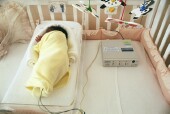
THURSDAY, March 3 (HealthDay News) — A new Australian study finds that babies who sleep on their stomachs — a position thought to pose a risk for SIDS — have lower levels of oxygen in their brains than those who sleep on their backs.
The discovery suggests that a lack of oxygen could explain why babies in such a position are at a higher risk of sudden infant death syndrome while sleeping: Their brains may be less able to wake them up when they’re in danger from not breathing.
The research also backs current recommendations on the prevention of SIDS that suggest infants be put on their backs to sleep. “For a lot of parents, it’s important for them to know why something works before they do it. If we can make this link, if we can say that if your baby is on his stomach, he’s not getting enough oxygen to his brain, it’ll help parents see why this might be true,” said Dr. Rachel Moon, a pediatrician at Children’s National Medical Center who studies SIDS.
The disorder has been documented since Biblical times, when it was called overlaying, explained study co-author Rosemary S.C. Horne, of the Ritchie Centre for Baby Health Research at the Monash Institute of Medical Research at Monash University in Melbourne. From the 1960s to the 1980s, the number of SIDs cases rose because parents were encouraged to put their babies to sleep on their stomachs, Horne said.
“This was advocated, as sick preterm infants were shown to breath better in this position,” she said. “It was a case of changing infant care practices without proper scientific evidence to do this. Around the world, most babies sleep on their backs and are even kept there in devices such as cradle boards.”
In the new study, the Australian researchers sought to better understand what happens when babies sleep on their stomachs and why they face a greater risk of not being able to rouse themselves when something goes wrong, such as when they stop breathing for a time.
The researchers tested 17 babies at different times during the first six months of life when they slept either on their backs or their stomachs. For safety, the babies were studied in a hospital “and were fully monitored throughout the study with heart rate, breathing and oxygen saturation recorded continuously,” Horne said.
The researchers found that the oxygen levels in the brain dipped when they slept on their stomachs. This may explain why babies who sleep on their stomachs are three times harder to arouse from sleep as other babies, Horne said. Previous research has shown that these babies also have lower blood pressure, although specialists have differed about whether that’s important.
“What still remains a mystery is why are some infants more vulnerable than others,” Horne said. “When in a life-threatening situation, most babies do not die. We are striving to understand all the processes involved so we can identify which infants are most vulnerable.”
The findings appear online Feb. 28 in the journal Pediatrics.
More information
For more about SIDS, try the U.S. National Library of Medicine.

